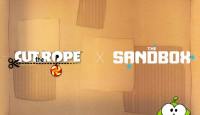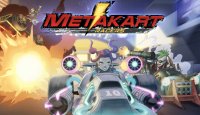On November 8th, founders of MixMarvel were invited to the 2019 Wuzhen World Blockchain Conference hosted by Babbitt. The conference gathered more than 100 global experts, scholars, opinion leaders, and famous project founders in the industries of blockchain, digital assets, AI, and 5G. The theme of the conference covers the application of blockchain, technology frontiers, industry trends, and hot issues, empowering the promotion of blockchain technology and industrial innovation.

MixMarvel Chief Strategy Officer (CSO), Mary Ma, appeared at the “Digital Assets: Birth, Deduction and Evolution” forum, where she delivered a speech on “GameFi — The Path of Technology-driven Innovation in the Game Industry.”
Here’s the summary of Mary Ma’s presentation:
Dear guests, thank you for having me here! Today, I would like to introduce our approach to using technology as a driving force to push the innovation of the industry and share our discoveries and thoughts.
Recently, everyone has been talking about the industries’ [influence on blockchain]. Let’s start with the industrial form of the game and blockchain combination, and open up the layers of fog to reveal its essence. I want to ask: how many people in the audience have played blockchain games? Has anyone ever bought Crypto Kitties? [People] who bought it early should have already made a profit. For blockchain games, the public’s perception is more into gambling or competitive games, or other so-called creative concepts. The blockchain game is a practical economic model that has already proven itself. Blockchain brings trust, and, combined with games, creates a trust game, which is logical.
Let’s talk about the Finance game for a moment. Tokens and assets can be created. Tokens have two cycles: the small circulation in the game and the big circulation in the industry. The digital assets are the NFTs (non-fungible tokens) we often refer to. After these factors were completed, the concept of GameFi was proposed, which is similar to the currently hot DeFi. [GameFi] is meant to create a gamification of finance and innovative gamification of business.

1. Blockchain games will create new markets and reshape the industry landscape
These thoughts and conclusions benefit from the essence of the mainstream game industry, accumulated by our entire team throughout 15 years. Our core members were core developers of Ubisoft, T3, The9, and Shanda. We have been immersed in the blockchain industry for two years now and have concluded two points.
Firstly, blockchain games have created a new liquidity market and a new investment target. Nowadays, we are mainly talking about FTs (fungible tokens), meaning, all the projects can issue their tokens based on the Ethereum protocol and sell them to investors. This prosperity stems from the simple one-click solution to create the investment target, which is much simpler than creating a new project on Bitcoin during its earliest times and then doing bitcoin forks. We believe that blockchain games can create a new liquidity market and new investment targets. On the other hand, NFTs are much more extensive; they are not just corporate interests or tokens used by the company, but also a prop, a role, or even a rule. We believe that any asset with value can be an NFT. Such a brand-new investment target is a new field developed by a new liquidity market.
Secondly, it has changed the process of value production in the game industry, reshaping production relations and industry patterns. This is the most exciting thing for us, and we will focus on its logic later on. The blockchain will not only bring improvement to the game industry but also reshape the industry structure. Although the path may be a bit long, we think it is an industry that can be reshaped first, or at least earlier than the physical world. We start from the needs of the industry and take the technological advancement as the driving force to achieve innovation in the game industry.

2. Blockchain hits the pain points of the game industry
But why does the industry need blockchain? The reason is for sure related to the pain points of the entire industry. In the whole game industry, there are three core groups of people: users, developers, and content producers.
For Users
The simplest example may be: I bought a piece of clothing in a store today. Even if the store closes after three months, the ownership of the garment is still mine. Clothes will not disappear because the store closed. However, in mainstream games, the end of the game’s life cycle means that the life cycle of the in-game items (primarily, services) that the user has purchased is over. Therefore, the virtual item does not have this attribute of physical assets, and the users do not have real ownership over the assets.
Secondly, the so-called assets are not expected to have an appreciation logic. Although there is a large number of prop markets where you can trade props, from a business point of view, they are more based on the needs of the game itself, and cannot interoperate with other games. User’s assets are difficult to circulate, so they do not have a rigorous appreciation logic, and it doesn’t have the support of the entire industry.
Thirdly, the users do not have opportunities for deep participation. Only passively accepting consumer goods, users do not have the chance to participate in the game production and manufacturing process.
For Developers
First of all, distribution channels are limited. At present, the entire game industry continues to expand — from 140 billion in 2018 to 150 billion dollars now (expected). Nevertheless, the number of distribution channels is decreasing, which means that [users] can receive less content and have fewer choices. In addition to that, there are less liquidation methods and less profit. This is a fundamental problem.
Secondly, the low efficiency of marketing. Every game is continuously getting users in the distribution process, and these results are difficult to be recreated.
Thirdly, the low success rate of games. For big manufacturers, only one of the six games might be successful. For 2D games, the game audience is relatively more concentrated, and the success rate is relatively higher. However, most small and medium-sized game developers have a success rate of only 1/20. The users’ requirements for the quality of the games are getting higher and higher, while the development cost is getting higher as well, which leads to a problem with content shortage.
For Content Producers
At last, there are content developers, including IP digitization, calling a wide variety of users and developers, IP realization, and more. Since the channel is relatively long, even if you have a good IP, you might need to realize it through a series of key links such as novels, movies, TV series, and games. Therefore, there is no way for creative content producers to monetize through any effective channels.
Based on the problem just mentioned, we found that the blockchain technology can reshape the entire industry. In the past, the industrial landscape of traditional games revolved around the three elements: promotion, distribution, and operation. But the future industry structure of blockchain games will rely upon three new factors: game assets, application scenarios, and value networks.
Since it comes to the economy, the economy consists of three features: productivity, production relations, and production factors. Let’s start with production factors. In the world of mainstream games, the game products have a one-way product sales process. After the game developers create the game, we think of how to reach users and make them consume. The key to it is the promotion, distribution, and operation — the economic elements of the old world. Every business activity is built around a separate old center, which is robust and does not have a productive collaboration system.
However, if we use the blockchain to rebuild the game industry, you will see that the object targets has changed. Just as the Internet target itself has been evolving step by step. Quite a long time ago, we carried out activities around the transmission of information. Later, we gradually explored the value of individuals and consumers behind the information and derived e-commerce, interpersonal social network platforms, and more. Then, stepping into the digital economy era we are now in, economic activities mainly rely upon data, and data has become our most important target. Nowadays, based on blockchain technology, the objects we deal with will be assets. With the help of more content creators developing content around assets, these assets will have a natural appreciation logic. When the application scenario is rich enough, it will be time to build a value network.
Thereby, the reason why blockchain games can reshape the industry landscape is that it changes the industry production relationships. The creators focus on the new production factor, game assets, to match the rich application scenarios and continuously improve the intrinsic value of the assets. In the new production relationship, the core is the game assets, the method is to enrich the application scenarios, and the purpose is to organize production more effectively. In the blockchain games’ world, the previously created digital assets can be called by a variety of users. Meaning, developers can reuse the already established game assets and combine them into diverse game content. These rich application scenarios and game assets will form a value network that will produce better synergy and create more mutually profitable situations than the mainstream split mode.
At this point, I would like to set the point of view of the Hong Kong Stock Exchange Qianhai United Trading Center as an example. Assets undergo three stages in the evolution process: asset standardization, asset datamation, and asset tokenization. For the mainstream industries, and for the manufacturing industries (the HKEx Qianhai United Trading Center is a mainstream industry), I think this is very logical. The Qianhai United Trading Center, as mainland China’s sole corporate center of the Hong Kong Stock Exchange, is engaged in spot pricing of bulk commodities in China. They changed the way mainstream banks credit SMEs, for instance, financial statements, fixed asset pledges, and group guarantees. They price these SMEs from the entire production process and standardize assets. Through IoT (Internet of Things) tracking of warehouse receipts, traceability through blockchains, and confirmation of property rights, they have a new process of reshaping assets. As an exchange, they find not only the price but also the issuer and discoverer of the asset, which dramatically enhances the efficiency of the entire mainstream manufacturing financing.
The blockchain game industry is quite similar. We not only have the price discovery after the generation of the digital asset but also intervene in the process of value production earlier. We then give it a series of application scenarios to let its intrinsic value continue to appreciate and finally create a value network. After this world has been created, what we believe the game will get more is to break through the barrier between the virtual world and the real world. Thereby, to truly achieve the effect of having a digital life as in having a second life.

3. Reduce cost by creating a game infrastructure: Rocket Protocol
Enough was said about the industry, now I want to talk about our technology. The underlying technology of the blockchain has been discussed by too many, including many developers on Devcon, but unfortunately there is no suitable infrastructure for the game developers. The main problem is the high cost of public chains and slow response. Through our Rocket Protocol and a set of C/S cloud architecture and a rich SDK, the game has achieved a good infrastructure of low cost and high concurrency.
Fast integration with C/S cloud
The role of our C/S cloud architecture is to eliminate the process of developers learning blockchain technology. We have encapsulated the underlying smart contracts and various gateways. For mainstream game developers, there is no need to change too many programming languages, and use the language they like to integrate the existing game on a blockchain quickly.
Comprehensive and easy-to-use SDK
We are building two bridges; one connects the developers and the blockchain world, the other connects the blockchain game and the users’ world. The C/S cloud architecture just mentioned is used to connect the developers. The SDK, on the other hand, combines the users. This is an issue-oriented SDK that encapsulates the player’s account system, marketing, multiple functions such as exchange, wallet, or community, to provide developers with a more straightforward development process that saves them 70–90% of the time. .
High-performance and scalable Rocket Protocol
The Rocket Protocol is what we are recently focusing on. We also hope that more developers will provide content on our platform. We can support all public chains and alliance chains with smart contracts. Under the calling of President Xi, many alliance chains have begun to pay attention to the blockchain, blockchain applications, and the game industry. Several major internet giants have also appeared in the morning, and we are talking with one of the tycoons about the development of an alliance chain. I hope that such utilization of blockchain games can be realized soon.

4. Blockchain Game Innovations
This is the result of a few attempts and verifications. Currently, we have developed three digital asset games.
HyperDragons | Virtual economy gives digital assets an appreciation logic
HyperDragons is a digital asset game that proves that the virtual economy can give digital assets an appreciation logic. In 2018, HyperDragons’s score exceeded Crypto Kitties. It has been at the forefront of the major public chain rankings for 18 months. We also proposed the concept of the token economy in the game for the first time in 2018.
HyperSnakes | Financial innovation allows users to create value by playing games
HyperSnakes is a light competitive game. We promote mass adoption of blockchain games through this game. Players can understand and participate in the game very easily. They can win rewards in the game by winning competitions. This is to attract users from an economic perspective and let them play this blockchain game.
Ground Hunter | Token incentives improve the efficiency of distribution and community governance
Ground Hunter reduces marketing costs through token incentives and attracts long-term loyal users through community governance.
We verified from different perspectives what direction should be taken for the development of blockchain games, and we will also launch more game products in the future.
Finally, I want to make a summary of our game world. Just now we have mentioned the Qianhai Mercantile Exchange, which revalues pricing and value transfer of traditional physical assets through the IoT and blockchain technology. The evolution of assets will undergo three stages including standardization, digitization, and tokenization. The game industry is already highly digitalized and will realize tokenization faster than the physical world.
On the MarvelLand platform, game assets can be reused, and users can be shared. At the same time, it is a highly autonomous community, where you can earn rewards by playing games, experience your second life, and even customize the look of it. Focusing on digital assets and rich application scenarios, plus different users, including developers, creators, players, and service providers, combined with blockchain, IoT, 5G, cloud games, and other technologies, this vision will undoubtedly be realized soon.
5. Road map
At the end of this year, the MarvelLand platform 1.0 will be launched. First, some essential functions will be realized. The 2.0 version will be further enriched. Each planet will have its unique theme, and each theme will have a corresponding series of content. The next step is to create a closed loop of the tokens, and finally a complete a whole ecosystem, which will be a highly autonomous community.
Finally, let’s show you the future shape of MixMarvel, and hope that more people will participate in blockchain games.
Thank you all!
MixMarvel community:











